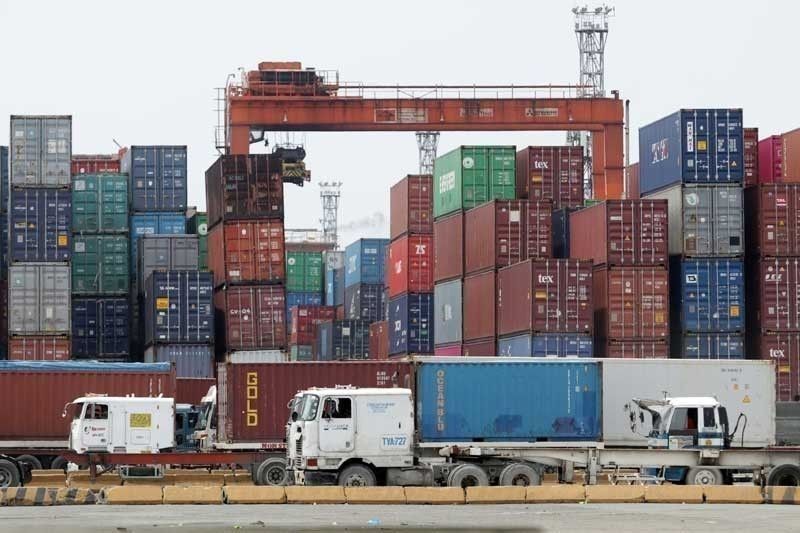Trade gap further widens in August

MANILA, Philippines — The country’s trade deficit continued to widen in August as both imports and exports are still on double-digit expansion mode due to low base effects and as economic activities improve.
The Philippine Statistics Authority (PSA) reported that the trade shortfall reached $3.58 billion in August, surging 64 percent from $2.18 billion in the same period last year, but lower than the $3.66 billion gap recorded a month ago.
As expected, the wider trade gap was mainly due to the faster 30.8 percent growth in imports to $10.04 billion in August, signaling improved demand and supply.
The country’s exports also benefited from improving demand from the global market, registering growth, although slower, of 17.6 percent to $6.47 billion from a year ago.
Overall external trade in goods in August went up 25.3 percent to $16.51 billion from $13.18 billion a year ago. It was also quicker than the 22.9 percent growth recorded in July.
For the eight-month period, the country’s trade shortfall expanded by 61 percent to $25.25 billion from $15.69 billion in the same period last year as imports continued to outpace exports.
ING Bank senior economist Nicholas Mapa said the latest widening of the trade deficit would add pressure to the peso.
With the higher trade gap, Mapa said concerns about the current account deficit are likely to surface as the so-called “twin deficits” threaten the pace of recovery.
A twin or double deficit happens when a country has both a current account deficit and budget deficit, which means that imports are higher than exports and, at the same time, government is spending more than what it is able to collect.
“With the current account balance swinging back into the red and the similar reversal in flows on the financial account, we could see the balance of payments edge closer to the red, resulting in a weaker currency,” Mapa said.
“We can expect the peso to face a depreciation bias to close out the year, especially with sentiment shifting back to developed market currencies, whose countries have fared much better in terms of pandemic response and as a result have enjoyed a quicker rebound for their economies,” he said.
Apart from the effects of low base from last year, the trade figures in August reflect improving overall economic activity, even if lockdown measures were reimposed during the month.
Imports continue to outstrip the country’s exports as the economy tries to exit from the pandemic-induced recession. Imports for the eight-month period rose by 31.1 percent to $74.18 billion.
In August alone, imports rose 31 percent with all major sectors posting gains, led by fuel imports which surged 116 percent following high energy prices in the international market amid supply chain bottlenecks.
Fuel imports in August reached $1.3 billion from just $603 million a year ago.
Apart from fuel, other inbound shipment of goods and services also expanded, with the sub-sectors of medicinal and pharmaceutical products, iron and steel, and plastics in primary and non-primary forms leading the growth. Capital goods expanded while raw materials also increased, particularly those used for electronics exports.
China is still the country’s biggest supplier of imported goods at $2.36 billion, or about 23.5 percent of total.
Mapa said the import flows signal at least a modest pickup in demand activity as mobility is slowly returning to normal.
“Rising raw materials imports and capital goods also signal likely improved demand as firms and the government work to catch up from the months’ long backlog of foregone investment activity that setback Philippine productivity,” he said.
Meanwhile, exports in August went up 17.6 percent to $6.47 billion. Year-to date, exports increased nearly 20 percent to reach $48.93 billion.
For August alone, dollar earnings from electronic products, the country’s top export, registered an increase of 17.6 percent to $3.69 billion.
Other exports showed strength during the month particularly coconut oil, cathodes, electronic equipment, and other mineral products.
The country’s top 10 exports, which cornered 83.6 percent of the total, went up 20 percent to $5.4 billion during the month.
The top 10 export destinations of the Philippines also increased by 17.6 percent to $5.74 billion.
Huge growth was seen in exports to Taiwan, Thailand and China, which was the top export destination totaling $1.05 billion or 16.2 percent of total exports.
Rizal Commercial Banking Corp. chief economist Michael Ricafort said the continued recovery of exports reflects the rebound of local manufacturing gauges which would further help in creating employment.
He added that the ongoing granular lockdowns boost economic reopening and business activities that could contribute to more improvements in exports.
“For the coming months, any further pick up in imports and exports would also be a function of more COVID-19 vaccine arrivals and rollouts, especially toward population protection and eventually herd immunity,” Ricafort said.
- Latest
- Trending





























